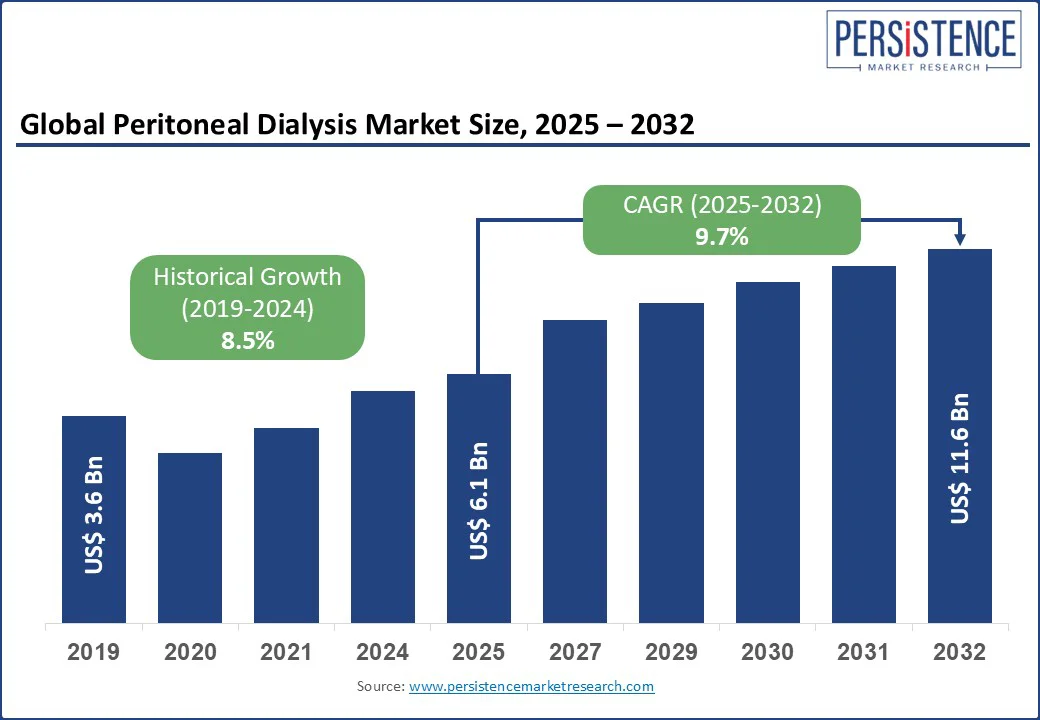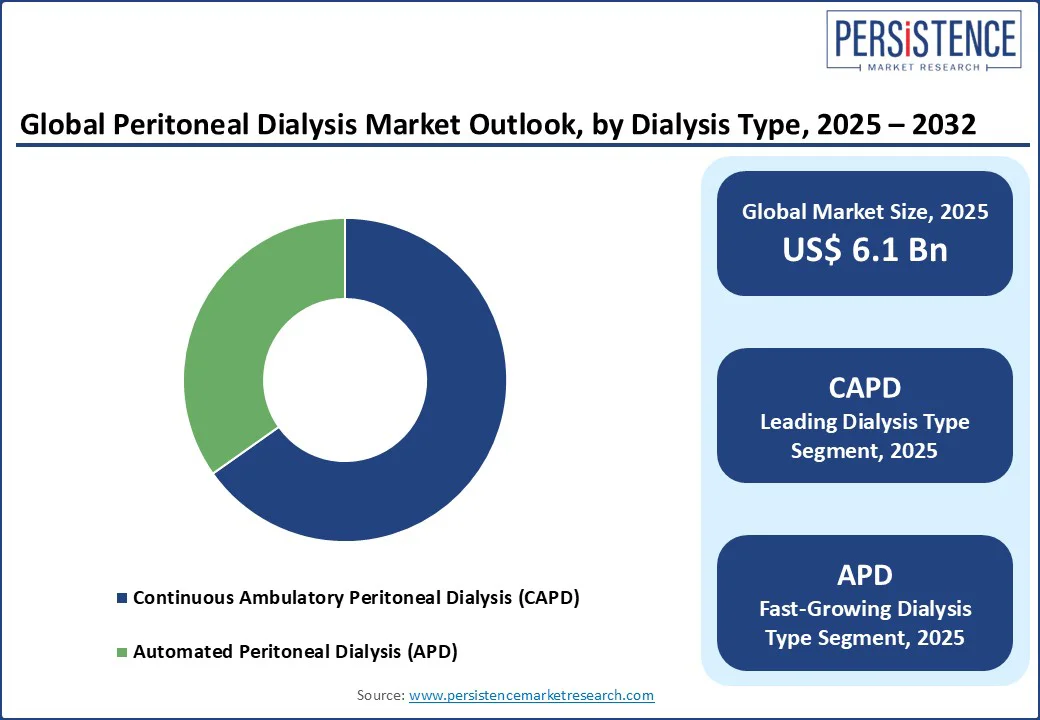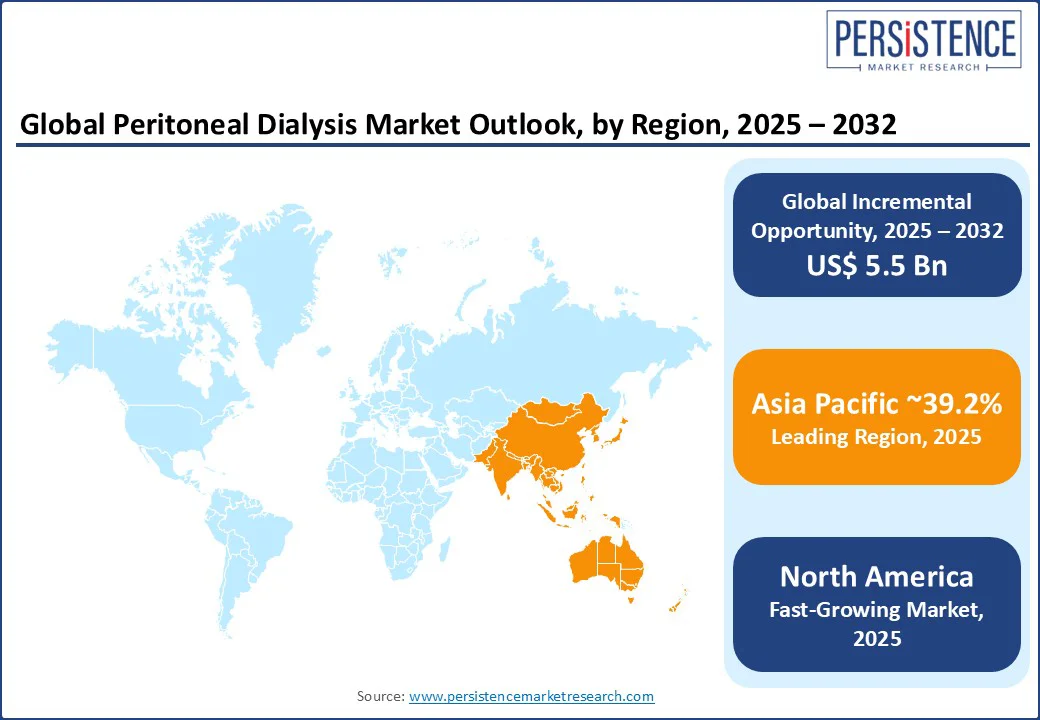ID: PMRREP35550| 192 Pages | 5 Aug 2025 | Format: PDF, Excel, PPT* | Healthcare

The peritoneal dialysis market size is likely to be valued at US$ 6.1 Bn in 2025 and is estimated to reach US$ 11.6 Bn in 2032, growing at a CAGR of 9.7% during the forecast period 2025-2032. Peritoneal Dialysis (PD) is emerging as a focal point in the global renal care market. It is spurred by increasing pressure on healthcare facilities to decentralize treatment, expand home-based modalities, and manage rising End-Stage Renal Disease (ESRD) prevalence among aging populations. For key players in the field of kidney dialysis equipment, the PD segment presents a high-margin and underpenetrated opportunity primed for disruption through localization and developments. As reimbursement policies shift to favor home therapies, leading companies investing in new solutions are expected to hold long-term competitive advantages.

Key Industry Highlights:
|
Global Market Attribute |
Key Insights |
|
Peritoneal Dialysis Market Size (2025E) |
US$ 6.1 Bn |
|
Market Value Forecast (2032F) |
US$ 11.6 Bn |
|
Projected Growth (CAGR 2025 to 2032) |
9.7% |
|
Historical Market Growth (CAGR 2019 to 2024) |
8.5% |
The increasing prevalence of renal impairment secondary to cancer therapies, trauma-related injuries, diabetes, and aging is spurring peritoneal dialysis market growth. It is evident in scenarios where vascular access is compromised or hemodynamic stability is important. Cancer patients undergoing nephrotoxic chemotherapies are presenting with Acute Kidney Injury (AKI) that progresses to Chronic Kidney Disease (CKD). In such immunocompromised individuals, PD is often preferred over hemodialysis due to its continuous mechanism and lower infection exposure in home settings.
In trauma cases involving crush injuries, PD is gaining traction as a Renal Replacement Therapy (RRT) in ICUs where hemodialysis often exacerbates hemodynamic instability. Among diabetics, who make up the most prominent group of ESRD patients globally, PD is becoming an essential option. It is attributed to ongoing developments in low-glucose and icodextrin-based solutions that reduce glycemic load during exchanges.
Technophobia and reluctance among elderly patients to use cyclers are creating a significant bottleneck in the wide adoption of PD. It is evident in regions where aging populations dominate the dialysis demographic. In Germany, Japan, and South Korea, studies have found that many elderly patients prefer in-center hemodialysis as they feel intimidated by the complexity of APD machines. This reluctance is accelerated by physical limitations such as arthritis, cognitive decline, or visual impairment. These make using touchscreen or button-operated cyclers difficult.
In the U.K., for example, the National Kidney Federation reported in 2022 that around 30% of elderly patients trained for home-based PD eventually transitioned to in-center treatment in the first year. It was due to challenges in operating cyclers independently. This trend not only stalls the expansion of PD but also places additional pressure on already overburdened hemodialysis centers. To address these challenges, a few healthcare facilities have introduced assisted PD models, where trained caregivers or community nurses operate the cyclers on behalf of the patient.
The integration of PD into Chronic Kidney Disease (CKD) management is creating new avenues by positioning PD as an early treatment option rather than a last-resort intervention. Conventionally, dialysis is initiated after the onset of ESRD, but several healthcare facilities are now embedding PD planning during the early CKD stages. It is being done through structured pre-dialysis education programs.
The U.S. Veterans Health Administration, for instance, reported in 2023 that early PD education led to a 45% surge in home dialysis uptake within one year of ESRD onset. This indicates a clear benefit of integration in care pathways. The shift is further supported by multidisciplinary CKD clinics that incorporate nephrologists, dietitians, and PD nurses who begin patient preparation well before dialysis becomes imminent. Integration also enables better vascular access planning and timely catheter placement for PD, addressing a key cause of delayed or failed therapy starts.
By dialysis type, the market is bifurcated into Continuous Ambulatory Peritoneal Dialysis (CAPD) and Automated Peritoneal Dialysis (APD). Among these, CAPD is projected to account for nearly 65.2% of the peritoneal dialysis market share in 2025 due to its simplicity, cost-effectiveness, and suitability for low-resource settings. It requires no electricity or machinery, allowing patients to perform exchanges manually throughout the day. This makes it suitable in regions with unstable power supply or limited healthcare infrastructure.
Automated Peritoneal Dialysis (APD) is gaining momentum owing to its ability to cater to modern lifestyle demands and the easy availability of digital health infrastructure. APD is primarily performed overnight using a cycler machine, allowing patients to maintain daytime freedom for work or social activities. This convenience has bolstered its popularity in high-income countries. APD is also preferred in pediatric nephrology due to better fluid management and reduced caregiver burden during the day.
Based on product type, the market is trifurcated into cyclers, fluids, and other accessories. Out of these, fluids are estimated to hold about 54.3% of the share in 2025 as they represent a high-volume and recurring consumable essential for every PD session. This makes them the most commercially important component of the treatment cycle. Developments in biocompatible and low-glucose PD fluids are changing clinical outcomes, further bolstering their importance. Baxter and Fresenius have already introduced next-generation fluids with neutral pH and reduced glucose degradation products, which have exhibited low peritonitis risk over long-term use.
Cyclers are gaining traction because of their role in enabling APD, which is becoming the preferred modality in several developed and urbanizing healthcare systems. These machines automate the exchange process overnight, allowing for increased patient autonomy and better integration into modern lifestyles. The real momentum, however, stems from the increasing integration of connectivity and remote monitoring features. For example, Baxter’s AMIA with Sharesource and Fresenius's Liberty Select cyclers have enabled healthcare providers to track treatment data in real time.

Asia Pacific is predicted to account for approximately 39.2% of share in 2025 owing to increasing burden of ESRD, insufficient hemodialysis infrastructure, and the push for home-based care. China and India are at the forefront of this growth. In China, growth is supported by government-backed programs in several provinces and expanded reimbursement coverage under national health insurance. Leading manufacturers are actively broadening their product lines, boosting local development, and cost reduction.
In India, PD penetration remains below 10% of total dialysis patients. However, recent moves by the government under the Pradhan Mantri National Dialysis Program have encouraged the inclusion of PD services in public hospitals. The launch of indigenous PD fluid production by domestic players is reducing dependency on imports and lowering treatment costs, making it accessible in Tier 2 and Tier 3 cities. Japan and Taiwan continue to exhibit steady regulatory and insurance support for PD, but adoption remains moderate due to cultural preferences for in-center hemodialysis.
In North America, the U.S. peritoneal dialysis market is anticipated to dominate through 2032 with federal policy changes and rising healthcare cost concerns. The U.S. Centers for Medicare & Medicaid Services (CMS) launched the ESRD Treatment Choices (ETC) model in 2021. It financially incentivizes providers to increase home dialysis adoption, including PD. Leading providers such as DaVita and Fresenius are hence extending their PD programs, including training centers and telehealth-enabled patient monitoring.
DaVita reported that approximately 20% of its new dialysis starts in 2023 were on PD, attributing the growth to extended virtual care options and patient outreach campaigns. Remote monitoring platforms, including Baxter’s Sharesource, have also gained impetus with over 25,000 U.S. patients using connected cyclers that allow nephrologists to adjust treatment settings remotely. While PD utilization rates in Canada have remained relatively high historically, recent data from the Canadian Institute for Health Information (CIHI) shows stagnation in growth. This is due to the dominance of in-center services and aging PD patient cohorts transitioning to hemodialysis backed by complications.
In Europe, the U.K., Sweden, and Denmark are witnessing increased PD uptake, propelled by favorable home dialysis policies and integration of digital health tools. In the U.K., the National Health Service (NHS) indicated a 17% surge in the number of patients on PD between 2021 and 2023. It was primarily pushed by the Home Dialysis Improvement Initiative, which incentivizes providers to deliver more flexible and patient-centric options.
Germany and France continue to favor in-center hemodialysis due to well-established provider systems and reimbursement structures that do not adequately promote PD. In Germany, PD represents less than 5% of dialysis modalities, reflecting provider hesitation and limited investment in PD-specific infrastructure. However, this trend is slowly shifting as cost-containment pressures and an aging population compel healthcare institutions to reconsider home-based alternatives.

The peritoneal dialysis market consists of a small group of dominant players and a surging number of regional manufacturers who are competing through cost-effective solutions. Key players are dominating with comprehensive product portfolio, home dialysis systems, and extensive distribution networks. Technological development is becoming a key differentiator. Start-ups and small-scale med-tech firms are exploring wearable dialysis devices and biocompatible PD fluids to gain a high share. Companies focusing on sustainability and patient-centricity are also gradually carving out niche markets.
The peritoneal dialysis market is projected to reach US$ 6.1 Bn in 2025.
Government incentives promoting home dialysis and increasing patient preference for flexible care are the key market drivers.
The peritoneal dialysis market is poised to witness a CAGR of 9.7% from 2025 to 2032.
Collaborations with digital health start-ups and increasing localized fluid production activities are the key market opportunities.
Baxter International Inc., Fresenius Kabi AG, and Medtronic plc are a few key market players.
|
Report Attribute |
Details |
|
Historical Data/Actuals |
2019 - 2024 |
|
Forecast Period |
2025 - 2032 |
|
Market Analysis |
Value: US$ Bn/Mn, Volume: As Applicable |
|
Geographical Coverage |
|
|
Segmental Coverage |
|
|
Competitive Analysis |
|
|
Report Highlights |
|
|
Customization and Pricing |
Available upon request |
By Dialysis Type
By Product Type
By End-use
By Region
Delivery Timelines
For more information on this report and its delivery timelines please get in touch with our sales team.
About Author